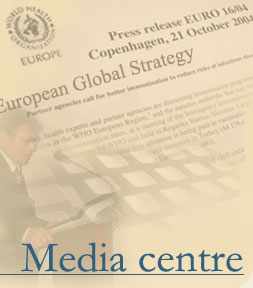Europe celebrates an historical milestone towards polio-free certification
Copenhagen • Stockholm
"I am pleased to announce that precisely two years have now elapsed since the last reported case of poliomyelitis occurred in the WHO European Region," declared Dr Marc Danzon, WHO Regional Director for Europe, at the opening of the Interagency Coordinating Committee meeting today in Copenhagen. "I wish to congratulate all the public health workers in our Member States, bilateral agencies and international partners whose hard work has brought about this amazing feat. This milestone places Europe firmly on track towards becoming fully certified as a polio-free Region by 2002."
Europe's last case of poliomyelitis occurred when a two-year-old unvaccinated boy in eastern Turkey became ill on 26 November 1998. Since that time, no further cases have been discovered in Turkey or in any other country of the European Region, even in the face of confirmed cases of poliomyelitis in countries bordering the Region. During these two years, the quality of surveillance in the countries of the Region has been improving to reach expected standards.
Success has come through well coordinated national immunization campaigns, collectively known as Operation MECACAR, including all high-risk countries in the WHO European and Eastern Mediterranean Regions. Since 1995 under these campaigns, two supplementary doses of poliomyelitis vaccine have been provided annually to up to 65 million children under 4-5 years of age in recently endemic countries. Since 1997, MECACAR has included special autumn mopping-up campaigns, including door-to-door mass vaccination, in high-risk areas of countries last reporting poliomyelitis cases, such as Turkey.
All these country actions have been supported by many bilateral and international partners. Major partners with the WHO European Region have been Rotary International, the Centers for Disease Control and Prevention in Atlanta, USA, the US Agency for International Development, the United Nations Foundation and UNICEF. These agencies came together in Copenhagen on 27-28 November, together with other international and bilateral agencies, at the Interagency Coordinating Committee meeting to discuss further cooperation in combating communicable diseases in European Member States.
"Rotary International is extremely proud of our financial and volunteer support to the work of public health staff in countries of the European Region to reach this wonderful milestone," noted Mr Asbjorn Austvik of Rotary International.
But the search for poliomyelitis cases continues. Dr Steven Wassilak, Medical Officer with the WHO Poliomyelitis Eradication Programme in Europe, explains why. "To be certain that poliovirus is still not circulating 'silently' - circulating without resulting in paralysed children - we as a Region must remain free of reported paralytic poliomyelitis cases, with a highly sensitive level of surveillance, for at least three years. This search means that all children with new paralysis, at least in all central and eastern European and central Asian countries, should be investigated and virologically tested to show no poliovirus".
A formal poliomyelitis eradication certification review process for countries in the WHO European Region has been under way since 1998. It is expected that the last six countries in the process (the Russian Federation, Tajikistan, Turkey, Turkmenistan, Ukraine and Uzbekistan) will have presented their required certification documentation by the end of 2001.
"Before the Region can be certified polio-free, however," notes Sir Joseph Smith, Chairman of the European Certification Committee, "we must be sure that not only does three years elapse without any poliomyelitis cases but that wild poliovirus in every European laboratory is safely contained or destroyed".
Laboratory containment of wild polioviruses is a complex issue, as all laboratories in each country of the Region must participate. This means, for example, that certain university laboratories outside the control of Ministries of Health will have to be willing to meet high standards of containment, or one day to destroy wild poliovirus and possibly infectious specimens in their possession. WHO will convene a subregional meeting in December 2000 in Prague, Czech Republic, at which participating countries will present their national plans for containment.
Surveillance is key. With the presence of wild poliovirus in neighbouring countries (Pakistan, for example, has had 120 cases of poliomyelitis confirmed to date in 2000 and India has had 315 cases) and increasing movements of populations into and within the WHO European Region, the risk of importation remains high. Poliovirus can be re-imported into a country in a matter of hours. Importations have been documented in France in 1996, China in 1998 and Syria in 1999.
The continued threat of importation of poliomyelitis will continue past the end of 2000 - the original target date for global eradication set in 1988 - since up to 20 countries are likely to still have poliovirus circulating at the end of this year. This includes large areas in Africa and the Indian subcontinent. However, Dr Nedret Emiroglu, acting WHO Regional Adviser for Immunization Issues, notes that "intensive efforts are well under way in the highest risk countries to vaccinate every single child, and the Poliomyelitis Eradication Initiative still aims to certify the world polio-free in the year 2005".
So far this year, 1590 cases of poliomyelitis have been reported worldwide; 7142 were reported in 1999. More than 190 countries and territories will have interrupted poliovirus transmission by the end of 2000. The Western Pacific Region of WHO, which includes China and major portions of South-east Asia, was declared polio-free on 29 October 2000. The Region of the Americas was declared polio-free in 1994. Like the countries of these regions, countries of the European Region will need to maintain high immunization coverage in routine vaccination and high quality surveillance up to the time that certification of global poliomyelitis eradication is achieved.
For more information, contact:
|
|
Communication and Advocacy |

